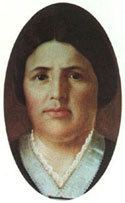Name Maria Lopez | ||
 | ||
Full Name Maria Ygnacia de la Candalaria Lopez Born January 31, 1793 ( 1793-01-31 ) San Diego, New Spain Died February 28, 1849, Sonoma, California, United States | ||
Maria Ygnacia Lopez de Carrillo (January 31, 1793 in San Diego, New Spain – February 28, 1849 in Sonoma, California) was the original grantee of Rancho Cabeza de Santa Rosa, the land on which Santa Rosa, California would later be founded. She was also the mother of the woman after whom Benicia, California was named and the grandmother of Romualdo Pacheco, the 12th governor of California.
Contents
Biography
Ygnacia was born to Juan Francisco Lopez and Maria Feliciana Arballo on January 31, 1793 and baptized Maria Ygnacia de la Candalaria Lopez. She was baptized in the chapel of the Presidio of San Diego. Her father was a soldier of the guard in San Gabriel. Her mother was a mulatta who had accompanied the Anza Expedition as far as San Gabriel. Her father died when she was 7.
On September 3, 1809, Ygnacia married Joaquin Victor Carrillo, a soldier from Baja California. With Joaquin, she had thirteen children, twelve of whom survived to adulthood. Several went on to play notable roles in the early history of California. In 1821, Francisco María Ruiz, comandante of the Presidio of San Diego, built the family an adobe residence on the flats below the Presidio, where they lived for more than a decade. A portion of the Ruiz adobe, designated "Casa de Carrillo", still stands. After Joaquin's death circa 1836, Ygnacia and her nine unmarried children traveled north by ox-cart over 500 miles (800 km) to Sonoma, where they stayed with her son-in-law Mariano Guadalupe Vallejo.
In 1838, Ygnacia got Vallejo's permission to settle in an area north of Sonoma, along Santa Rosa Creek. Her sons, with help from native people and her son-in-law Salvador, built a large adobe, now known as Carrillo Adobe, near the creek. In 1841, Governor pro tem Manuel Jimeno confirmed her possession by granting her 8,885 acres (3,596 ha) of land, designated as the Rancho Cabeza de Santa Rosa. It was one of only a handful of California land grants made to a single woman. Ygnacia supervised the farming on her rancho, where wheat, barley, oats, corn, beans, peas, lentils, watermelons, and muskmelons were grown. Her son Ramon managed her livestock, which included 1,500 horses, 3,000 cattle, and sheep. She became fluent in the language of the native people.
During the Bear Flag Revolt of 1846, her son Julio and two of her sons-in-law were imprisoned at Sutter's Fort. The rancho's livestock, weapons, and provisions were confiscated.
In 1849, a year after Mexico ceded California to the United States, Ygnacia died. Her remains were interred in the chapel of the Mission San Francisco de Solano in Sonoma.
Carrillo Adobe
A Franciscan outpost named Assistencia Santa Rosa de Lima was begun on the site in sometime around 1829, but the project was abandoned due to secularization.
After Ygnacia's death, her son-in-law David Mallagh established a trading post and tavern in the adobe. Santa Rosa's first post office was located in the adobe. The trading business continued under various owners into the 1860s. The land passed to Gustav Hahman, who turned it into an orchard. In 1950, Archbishop John Joseph Mitty purchased the land for building the Cathedral of Saint Eugene and its associated school. The Diocese of Santa Rosa erected a chain-link fence around the ruins and made plans to restore the adobe, but these plans never came to fruition.
When surveyed in 1962, all that remained of the adobe was a three-room structure, 83 feet (25 m) by 21 feet (6.4 m) with a 10-foot (3.0 m) veranda on all sides.
In 2005, the City of Santa Rosa gave tentative approval for a developer's plan to build up to 165 units on the parcel and spend more than $300,000 to prevent further deterioration of the adobe itself. Archeological investigations in 2006 revealed that the adobe was built on sturdy stone footings. In 2012, vandals broke through the fence and stole some posts and beams, which were later found in a nearby encampment.
Sheltered by a metal-roofed pole structure, the ruins of Carillo Adobe are still visible at 38.4485°N 122.6836°W / 38.4485; -122.6836 (Carrillo Adobe) behind the Cathedral of Saint Eugene, near the intersection of Montgomery Drive and Franquette Avenue in Santa Rosa.
Her seven daughters
Her six sons
Grandchildren
Namesakes
In fiction
Ygnacia is the protagonist of Maria Carrillo, Daughter of California, a 2011 historical novel by Mary Cooney.
